Research Division
Reprinted from "INSULATORS - Crown Jewels of the Wire", April 1972, page 24
Dear Dora,
I wonder if any reader could tell me how many different W.U. Insulators
(identified by embossing) there are. I have the CD 125, 126, 127 and the two
rubber W.U. Insulators.
I am employed by W.U. Accounting, dog-gonit-never get to look for insulators on
company time. I also wonder if any Western Union people that collect insulators
subscribe to Crown Jewels. If so, I would like to hear from them.
I have heard that the B & O Insulators are found only in Texas. I know they
are found In Texas, but it seems unreal that they would not be an the B & O
Railroad. Do you know?
Sincerely,
Eddie Bratton
Josephine, Tex. 75064
Gentlemen,
I am curious about a CD 125 insulator I have. It is a skirt embossed A.U On the
dome is the Hemingray 1871 Patent Date. Wasn't A.U. (American Union) the
forerunner of Western Union? If so, why are the (CD 426) W.U.'s so much more
"crude" than the A.U.s? None of my A.U.'s have swirl starts and none
of them are overfills. Your answer will be greatly appreciated.
Thank you,
Jack Snyder
244 Waggoner
Toledo, Ohio 43612
Dear Mr. & Mrs. Harned,
I am enclosing a photo of a couple A.U. Insulators I have. I believe they are CD
427, but I can't find any in Mr. Milholland's book on this particular insulator.
It has A.U. on the front skirt, Patent Dec. 19, 1871 on the dome,
and a small letter on the back of the skirt. I would appreciate any information
you could give me on rarity, trade value, etc.
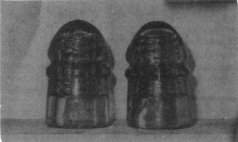
I also have another insulator I have questions about. It is embossed Armstrong's
TW on front, made In U.S.A. @ on back. CD 203 in Mr. Milholland's book has an
insulator with the same embossings, but this insulator has 2
grooves in the center of it, and they do not extend out further than the top nor
the first bottom groove. This one looks like a Hem. 25 with 3 rings in the
center.
We enjoy your Crown Jewels very much. Keep up the good work.
Best Collecting,
J. D. & Connie Hill
Dear Dora,
The other day I picked up a strange piece which I believe to be an insulator
made especially for wires going through large stone or brick walls on private
estates, but I really don't know. Enclosed is a drawing of it I sure would
appreciate some HELP! If it is an insulator, does it have any real value?
PORCELAIN (ONE PIECE)
HIGH LUSTER FINISH
COLOR BROWN Speckled with Black
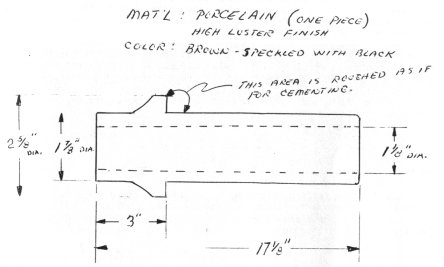
Also, one other question--I have an insulator almost identical to the Locke
#135, except all it carries is No 135. It is also a triple petticoat, whereas I
believe the Locke 135 is a double.
Thank you,
Bill Gormley
Lafayette Hills Apt
George St. Apt. G-1
Easton, Pa. 18042
I have a few insulators I have never seen in any books. Wonder if you can
tell me anything about them. I have one that looks like a Hemingray #9, but has
Rockingham #10 on it, in clear color. Then I have a few that have IN-56 on one
side and 15-45 on the other side.
Thank you
Ralph
Dear Sirs:
I recently acquired a large Hemingray power-type insulator. It is not in any
information I have. I don't have a photo, but it is shaped and about the size of
a CD237. It is green, has long, sharp drips, with 2 inner skirts. The skirt
embossing reads:
Front-HEMINGRAY/PAT. MAY 2, 1893;
Back-HIGH VOLTAGE/TRIPLE PETTICOAT/No
72.
If anyone has any information on this it would be most helpful.
Thank you,
J. L. Harris
Seaford, Delaware
Just a couple notes regarding January Crown Jewels. Referring to page 18: the
IN-56 is an Owens-Illinois product, World War II period. The insulator as drawn
is not complete; It has a steel lag screw which was fastened into the hole with
metallic cement. Collectors melt this out so they can have just the glass, in
the same way as is done with the large Pyrex suspension units. The IN-56 was
probably produced for the Army Signal Corps as an all-purpose insulator that
could be easily affixed to any pole or wooden structure in any country without
regard to the existing type of insulators or pins. I have seen many of these for
sale with army surplus during the 1950's. But we should ask Dennis Donovan; he
perhaps has more complete information!
Regarding the picture on page 26: The wires strung on saddle insulators are
incorrectly referred to as telephone lines. They are direct current electric
lines. This must have been very near a generating plant, with the separate
circuits operating at relatively low voltage and terminating at nearby
buildings. The lines on the shorter poles are probably feeder lines for the
street cars.
Very truly,
N. R. Woodward
Editor's note:
Have had numerous letters referring to the IN-56 small glass insulator pictured
In January issue, page 18. Owens-Illinois was originally the Hemingray plant.
From the volume of mail on this little insulator, Owens-Illinois must have made
thousands of these. They are not expensive.
Dear Dora
Enclosed is a drawing of an Insulator which I picked up last summer,
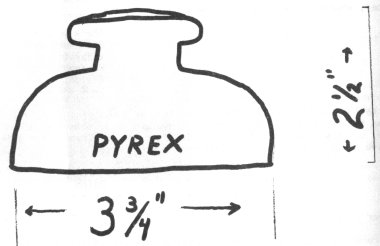
It is embossed "Pyrex" on the front and "Pat. app. for"
in the back. It has a 5/8" pin hole and a triple petticoat; is clear, but
has a light irridescence to it. Have nicknamed it "the knob top". We
have shown it to some collectors in our area, but no one has ever seen one
like it or knows anything about it. Perhaps some of your readers could give me
some information on it.
We enjoy reading your magazine and look forward to its arrival each month.
Sincerely,
Frank Prinzinger
Douglasville, Pa. 19518
Find enclosed picture of insulators we would like more information on. They
are numbers 3, 4 & 7.
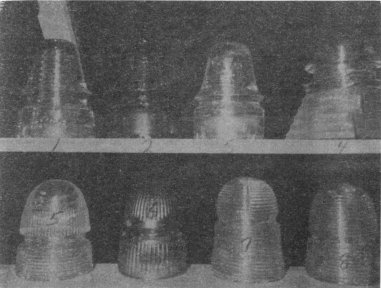
No. 1 Is C.D.# 162 - 1678 straw.
No. 2 is C.D.# 162 - no embossing, deep purple.
No. 3 is C.D.# 133? - base embossed AM. INSULATOR CO. N.Y. DOUBLE PETTICOAT -
PATIO SEPT. 13 1881. NOV. 13 1883. Have not heard of one with this embossing.
No. 4 is C.D.#154 -DOMINION-42 with a two piece metal cover on skirt. Have found
three of these on old railway line and wonder if they are very common. Could you
suggest a value?
No. 5 is C.D.# 143 - pleated top and horizontal ridges, bottom with Canadian
Pacific RY. CO. faintly between ridges.
No. 6 is C.D.# 143 pleated top and bottom, no embossing.
No. 7 Is C.D.# 145? horizontal ridges base to crown, no embossing. I found two
of these on a line that had a few of the other three lined ones. Does anyone
else have one? I presume it would be a Withycombe. Since he has four patent
numbers, could this be the fourth one? It is barely more than one-eighth inch
higher than the C.D.# 143. Note location of wire groove.
No. 8 is C.D.# 143 horizontal ridges base to crown.
NOTE: On No.'s 5, 7 & 8 the ridges below wire groove are not really
horizontal, but rather as though they were threaded. No. 8 is very much so.
Would like to hear from anyone with more Information on these.
We would also like to compliment you on a truly fine magazine. We certainly do
enjoy it.
Sincerely,
Walt & Charlotte Besler
5327 Lasalle Cr. S.W.
Calgary, Alberta, Canada
Dear Don & Dora:
I have a No. 20 Hemingray amber, front Hemingray 20, back Made In U. S A 16-42
:::. While visiting other collectors in Antioch, Cal., someone asked if I had
ever seen a 20 in amber. I answered, "Yes, I have one."
I have checked it against the clear. It has Hemingray 20 on the front, and on
the back Made in U. S. A 20-42 :::::: .
I would like to know if this is a baked insulator; also, if not a fake, what
value?
Yours truly,
Ken Herring
155 Wall St.
Livermore, Cal. 94550
Sounds like a cobalt treatment to me. I'm sorry. (Your Editor)
Dear Editor,
I was walking an old line and came across several H. G. CO. Petticoat beehives.
As I was cleaning them up I noticed one beehive had the "ghost" word
Petticoat "floating" just above the ordinary Petticoat embossing. The
letters of the "ghost" Petticoat are slightly indented around the
edges with the centers being about the level of surrounding glass. The
insulator is normal in every other respect,--so my questions are:
1. How could a ghost word like this be formed in the first place?
2. Rarity, - Just how common is this mistake? (I've never seen another insulator
like it.)
3. What is the trade value? (If any!)
Any help at all on this will be greatly appreciated. Thanks!
Sincerely,
Mike Bonne
R R 1
Knightstown, Ind. 46148
Dear Dora,
I recently acquired an insulator that I would like to find out something about.
It is a CD 145, NO Name, gold in color. I bought this In Los Angeles.
I would be Interested In anything you or your readers could tell me about this
NO Name, especially the value. No one I have talked to so far has ever heard of
it.
Sincerely,
David Gray
408 Wyncrest Dr.
Manchester, Mo. 63011
Editor's Note: All of these gold No-Names that we have seen have come out of
Canada, but possibly someone else has more or other info??
Dear Dora,
My wife and I enjoyed the show at Bakersfield very much (our first). We came
home with eight new insulators. Being just beginners we were really happy to add
to our collection, and it made the itch more unbearable.
We have in our collection a CD 145. On the front skirt is embossed a B, and on
the opposite side a numeral 4. The nearest thing to it in Milholland's book is a
B on front and #44 on back. Was wondering if anyone has any info on this one?
Well, that's all for now. Was very pleased to meet you at the show.
Sincerely,
Robert L. Davis
Dear Sir,
Your publication is the greatest. Enclosed is a photostat copy of the cover of
the World Fair greeting from The Jeffrey Mfg. Co. In 1893.
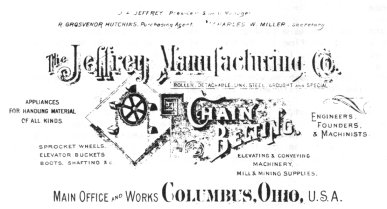
On page 7 It states, "We make a specialty of equipping mines with complete
electric plants."
Thought this might be helpful with the identification of the Jeffrey Mine
insulator.
Jeff Meston
21883 Hoffman Way
Castro Valley, CA 94546
| 